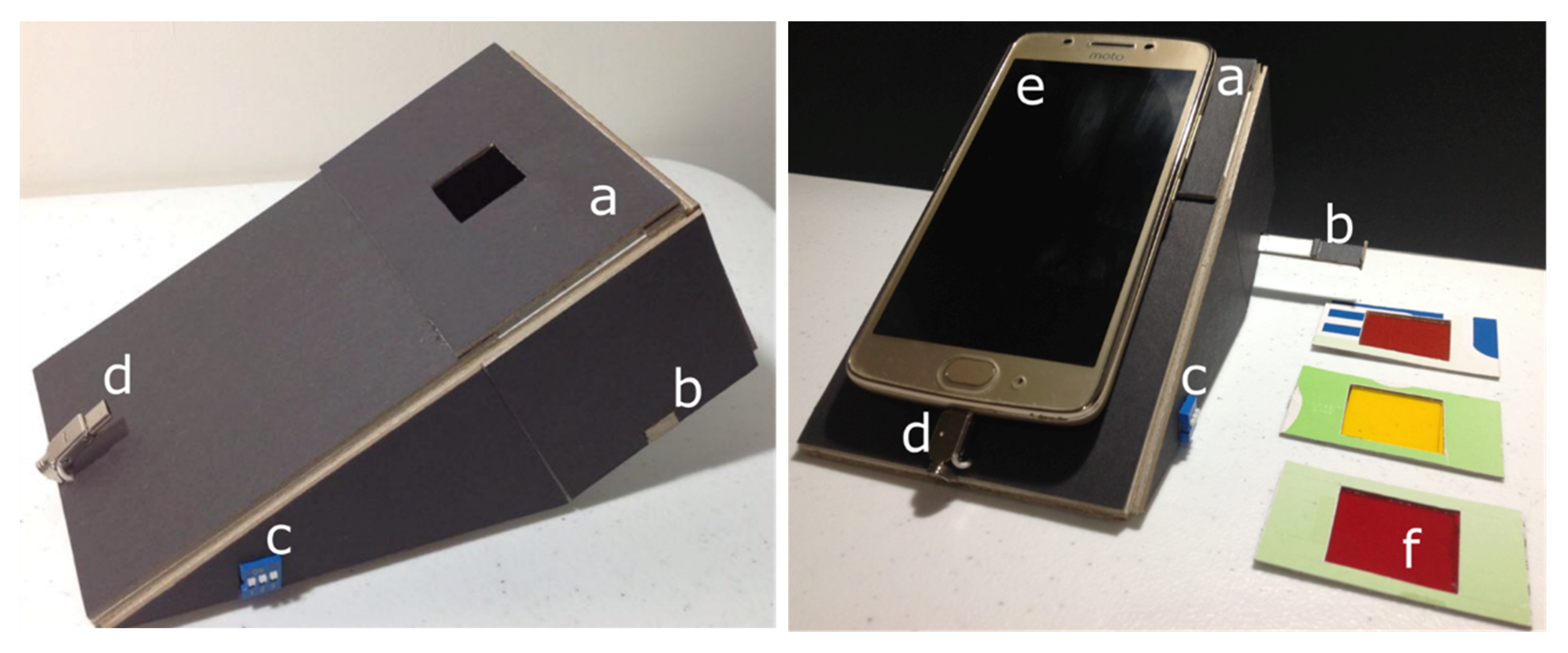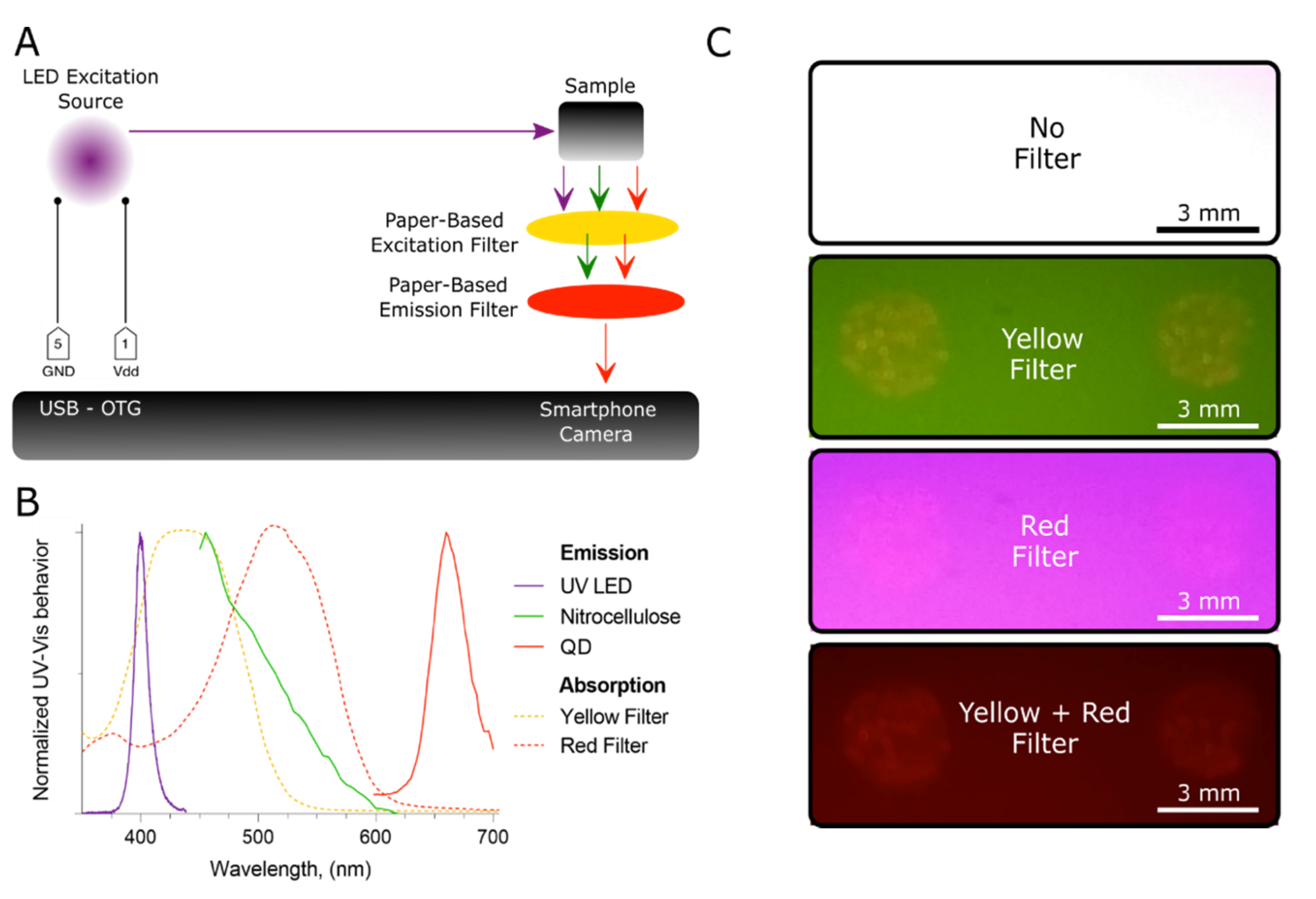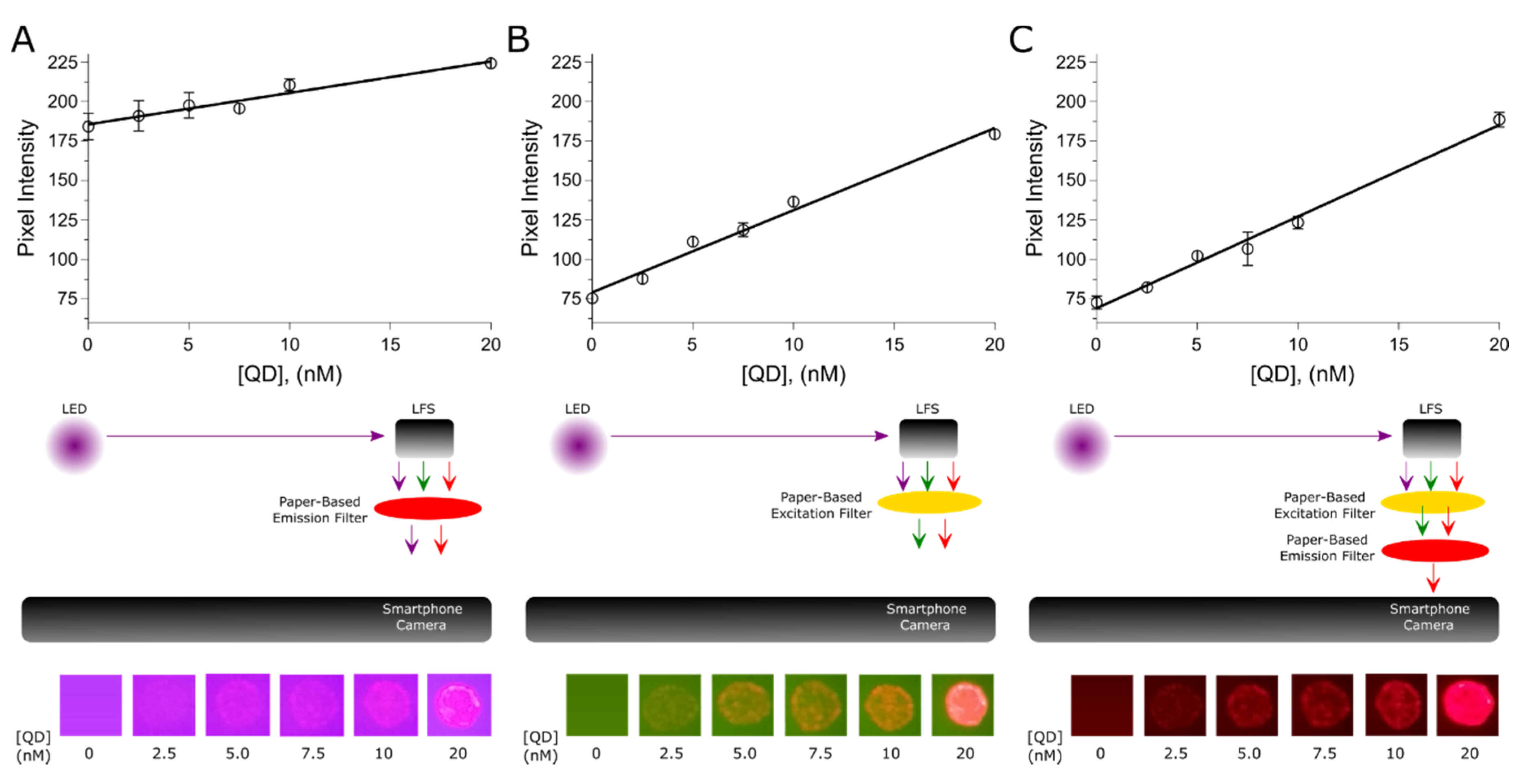Smartphone and Paper-Based Fluorescence Reader: A Do It Yourself Approach
Abstract
1. Introduction
2. Materials and Methods
3. Results and Discussion
3.1. Design of the Paper-Based Quantum Dot (QD) Reader
3.2. Ultraviolet–Visible (UV–Vis) Characterization of the Paper-Based Filters
3.3. Analytical Behavior of the Resulting QD Reader
4. Conclusions
5. Patents
Supplementary Materials
Author Contributions
Funding
Acknowledgments
Conflicts of Interest
References
- Fu, L.-M.; Wang, Y.-N. Detection methods and applications of microfluidic paper-based analytical devices. TrAC Trends Anal. Chem. 2018, 107, 196–211. [Google Scholar] [CrossRef]
- Marquez, S.; Morales-Narváez, E. Nanoplasmonics in paper-based analytical devices. Front. Bioeng. Biotechnol. 2019, 7, 69. [Google Scholar] [CrossRef] [PubMed]
- Liang, J.; Jiang, C.; Wu, W. Toward fiber-, paper-, and foam-based flexible solid-state supercapacitors: Electrode materials and device designs. Nanoscale 2019, 11, 7041–7061. [Google Scholar] [CrossRef] [PubMed]
- Marquez, S.; Liu, J.; Morales-Narváez, E. Paper-based analytical devices in environmental applications and their integration with portable technologies. Curr. Opin. Environ. Sci. Health 2019, 10, 1–8. [Google Scholar] [CrossRef]
- Chang, J.; Li, H.; Hou, T.; Li, F. Paper-based fluorescent sensor for rapid naked-eye detection of acetylcholinesterase activity and organophosphorus pesticides with high sensitivity and selectivity. Biosens. Bioelectron. 2016, 86, 971–977. [Google Scholar] [CrossRef]
- Sun, H.; Jia, Y.; Dong, H.; Fan, L.; Zheng, J. Multiplex quantification of metals in airborne particulate matter via smartphone and paper-based microfluidics. Anal. Chim. Acta 2018, 1044, 110–118. [Google Scholar] [CrossRef]
- Dincer, C.; Bruch, R.; Costa-Rama, E.; Fernández-Abedul, M.T.; Merkoçi, A.; Manz, A.; Urban, G.A.; Güder, F. Disposable sensors in diagnostics, food, and environmental monitoring. Adv. Mater. 2019, 31. [Google Scholar] [CrossRef]
- Christodouleas, D.C.; Kaur, B.; Chorti, P. From point-of-care testing to eHealth diagnostic devices (eDiagnostics). ACS Cent. Sci. 2018, 4, 1600–1616. [Google Scholar] [CrossRef]
- Gao, X.; Li, X.; Sun, X.; Zhang, J.; Zhao, Y.; Liu, X.; Li, F. DNA tetrahedra-cross-linked hydrogel functionalized paper for onsite analysis of dna methyltransferase activity using a personal glucose meter. Anal. Chem. 2020, 92, 4592–4599. [Google Scholar] [CrossRef]
- Liu, X.; Li, X.; Gao, X.; Ge, L.; Sun, X.; Li, F. A universal paper-based electrochemical sensor for zero-background assay of diverse biomarkers. ACS Appl. Mater. Interfaces 2019, 11, 15381–15388. [Google Scholar] [CrossRef]
- Liu, L.; Yang, D.; Liu, G. Signal amplification strategies for paper-based analytical devices. Biosens. Bioelectron. 2019, 136, 60–75. [Google Scholar] [CrossRef] [PubMed]
- Howes, P.D.; Chandrawati, R.; Stevens, M.M. Colloidal nanoparticles as advanced biological sensors. Science 2014, 346. [Google Scholar] [CrossRef] [PubMed]
- Resch-Genger, U.; Grabolle, M.; Cavaliere-Jaricot, S.; Nitschke, R.; Nann, T. Quantum dots versus organic dyes as fluorescent labels. Nat. Methods 2008, 5, 763–775. [Google Scholar] [CrossRef] [PubMed]
- Ming, K.; Kim, J.; Biondi, M.J.; Syed, A.; Chen, K.; Lam, A.; Ostrowski, M.; Rebbapragada, A.; Feld, J.J.; Chan, W.C.W. Integrated quantum dot barcode smartphone optical device for wireless multiplexed diagnosis of infected patients. ACS Nano 2015, 9, 3060–3074. [Google Scholar] [CrossRef]
- Rajendran, V.K.; Bakthavathsalam, P.; Bergquist, P.L.; Sunna, A. Smartphone detection of antibiotic resistance using convective PCR and a lateral flow assay. Sens. Actuators B Chem. 2019, 298. [Google Scholar] [CrossRef]
- Shah, K.G.; Singh, V.; Kauffman, P.C.; Abe, K.; Yager, P. Mobile phone ratiometric imaging enables highly sensitive fluorescence lateral flow immunoassays without external optical filters. Anal. Chem. 2018, 90, 6967–6974. [Google Scholar] [CrossRef]
- Morales-Narváez, E.; Montón, H.; Fomicheva, A.; Merkoçi, A. Signal enhancement in antibody microarrays using quantum dots nanocrystals: Application to potential alzheimer’s disease biomarker screening. Anal. Chem. 2012, 84, 6821–6827. [Google Scholar] [CrossRef]
- Hassan, A.H.A.; Bergua, J.F.; Morales-Narváez, E.; Mekoçi, A. Validity of a single antibody-based lateral flow immunoassay depending on graphene oxide for highly sensitive determination of E. coli O157:H7 in minced beef and river water. Food Chem. 2019, 297. [Google Scholar] [CrossRef]
- Reinhard, E.; Khan, E.A.; Akyz, A.O.; Johnson, G.M. Color Imaging: Fundamentals and Applications; A K Peters/CRC Press: Natick, MA, USA, 2008; ISBN 1-56881-344-9. [Google Scholar]
- Carrilho, E.; Martinez, A.W.; Whitesides, G.M. Understanding wax printing: A simple micropatterning process for paper-based microfluidics. Anal. Chem. 2009, 81, 7091–7095. [Google Scholar] [CrossRef]
- IJ_Mobile for Android—APK Download. Available online: https://apkpure.com/ij-mobile/com.ij_mobile (accessed on 11 December 2019).
- Otsu, N. A threshold selection method from gray-level histograms. IEEE Trans. Syst. Man Cybern. 1979, 9, 62–66. [Google Scholar] [CrossRef]
- Paterson, A.S.; Raja, B.; Mandadi, V.; Townsend, B.; Lee, M.; Buell, A.; Vu, B.; Brgoch, J.; Willson, R.C. A low-cost smartphone-based platform for highly sensitive point-of-care testing with persistent luminescent phosphors. Lab Chip 2017, 17, 1051–1059. [Google Scholar] [CrossRef] [PubMed]



| Configuration | Linear Model | R2 | 1/slope | LOD 1 (nM) | LOQ 2 (nM) | Linear Range (nM) |
|---|---|---|---|---|---|---|
| Red filter | Y = 1.994*X + 185.6 | 0.9455 | 0.5014 | 11.856 | 42.201 | 2.5–20 |
| Yellow filter | Y = 5.206*X + 79.12 | 0.9834 | 0.1921 | 0.918 | 4.744 | 2.5–20 |
| Red + yellow filter | Y = 5.81*X + 69.06 | 0.9892 | 0.1721 | 2.773 | 7.778 | 2.5–20 |
| ESEQuant | Y = 15.98*X − 3.454 | 0.9772 | 0.06256 | 0.303 | 0.314 | 2.5–10 |
| Reported Price (USD) | Filters/Lens | Smartphone | Reference |
|---|---|---|---|
| 8450 | Not specified | – | ESEQuant LR3 |
| 10 1 | No | High-range (iPhone SE or Nexus 5) | [16] |
| 5 2 | Yes/Yes | High-range (iPhone 5s) | [23] |
| 4.5 3 | Yes/No | Mid-range (Moto G5) | This work |
© 2020 by the authors. Licensee MDPI, Basel, Switzerland. This article is an open access article distributed under the terms and conditions of the Creative Commons Attribution (CC BY) license (http://creativecommons.org/licenses/by/4.0/).
Share and Cite
Ireta-Muñoz, L.A.; Morales-Narváez, E. Smartphone and Paper-Based Fluorescence Reader: A Do It Yourself Approach. Biosensors 2020, 10, 60. https://doi.org/10.3390/bios10060060
Ireta-Muñoz LA, Morales-Narváez E. Smartphone and Paper-Based Fluorescence Reader: A Do It Yourself Approach. Biosensors. 2020; 10(6):60. https://doi.org/10.3390/bios10060060
Chicago/Turabian StyleIreta-Muñoz, Laura Alejandra, and Eden Morales-Narváez. 2020. "Smartphone and Paper-Based Fluorescence Reader: A Do It Yourself Approach" Biosensors 10, no. 6: 60. https://doi.org/10.3390/bios10060060
APA StyleIreta-Muñoz, L. A., & Morales-Narváez, E. (2020). Smartphone and Paper-Based Fluorescence Reader: A Do It Yourself Approach. Biosensors, 10(6), 60. https://doi.org/10.3390/bios10060060






